- The oil glut created from COVID-19 outbreaks has been erased, and global oil inventories have fallen to the low end of their historical range.
- Oil supply growth remains impaired due to capital starvation, not just in the U.S. but globally.
- With oil demand projected to reach new record highs in 2022, the stage is set for $100 oil, with a growing tail-risk to much higher prices.
- The energy sector offers a rare spot of value in an otherwise overvalued stock market, while also offering protection against inflation.
Today’s stock market presents a great dilemma for investors.
With valuations inflated to near all-time highs, the broader U.S. stock market (i.e. S&P 500) offers low or negative future returns:
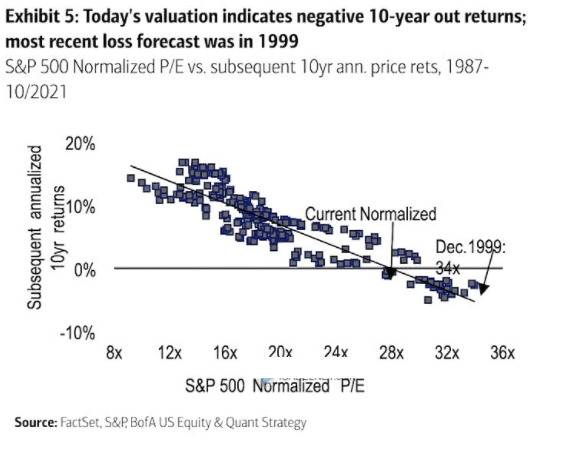
Meanwhile, with inflation running at 40-year highs, holding cash guarantees a loss in purchasing power. The energy sector offers a lone bright spot of value, plus inflation protection, in an otherwise overvalued and dangerous stock market.
The opportunity becomes even more compelling if you believe in the prospect of higher oil and gas prices.
A Rare Value Opportunity in Today’s Market
Whether we’re talking exploration and production companies (E&Ps), refiners, or midstream operators, you can find double-digit free cash flow yields across the board in top-tier North American energy stocks. The chart below shows the scope of today's massive valuation disparity in the case of the exploration and production sector versus the S&P 500:
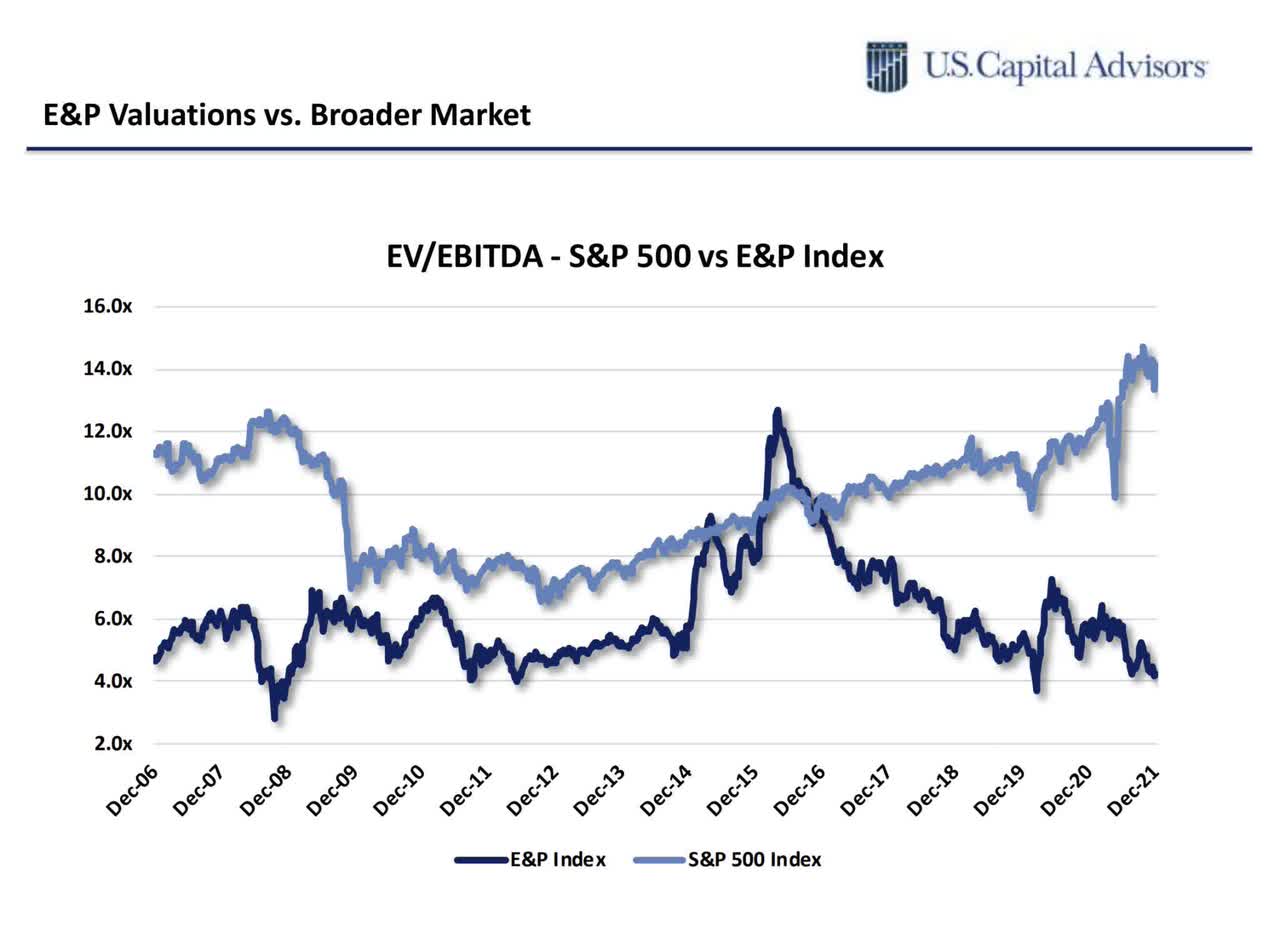
As one particular example in the midstream space, I recently made the bullish case for midstream company Enterprise Products Partners (NYSE:EPD). In the article, I explained how Enterprise would likely offer investors a 15% compounded return under conservative assumptions, with upside to 20–30% annual returns under more optimistic assumptions. A big part of this thesis relies upon Enterprise paying out a growing distribution yield to investors.
Last week, Enterprise management announced a 3.3% boost in its quarterly distribution. The company will now pay out $1.86 per year to investors, and is now going on 24 years of consecutive distribution increases—a trend I expect will continue for years to come. Management also took advantage of the depressed unit price in the fourth quarter to repurchase $125 million of the company’s common units.
In short, the bullish thesis remains intact, and Mr. Market is starting to notice—with EPD units up 10% in the last two weeks alone.
Longer-term, Enterprise remains my favorite “sleep well at night” energy pick. Regardless of where oil or gas prices go next, the business will likely continue growing cash flows and rewarding investors with a growing distribution.
But here’s the thing…
If oil goes to $100 per barrel, you can do a lot better than “sleep well at night.” In that scenario, companies with more direct commodity price exposure could offer much more upside. Specifically, I’m talking about the exploration and production (E&P) sector.
Today you can find blue chip E&Ps trading at very attractive cash flow yields, even assuming flat to slightly lower oil prices. These companies also enjoy substantial leverage to higher oil prices, providing investors with a great hedge against inflation.
Here’s How Oil Could Hit $100
Starting on the inventory side of the equation, the global oil glut created in the wake of the COVID-19 outbreak has officially been erased. Today, global crude stocks sit near the bottom of their historical range. Looking ahead, the U.S. Energy Information Agency (EIA) projects global inventories will remain depressed throughout 2022:
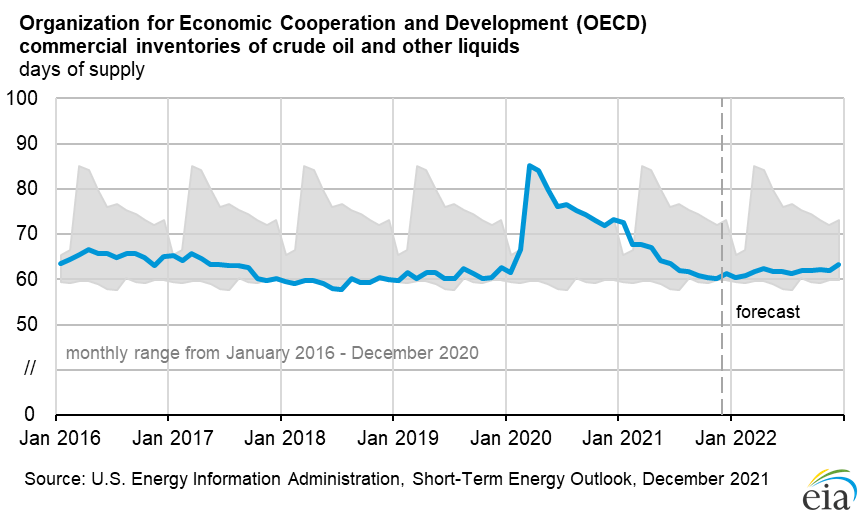
Notably, when this forecast was made in early December, the EIA assumed a potential demand hit from the Omicron variant of the COVID-19 virus, noting:
The potential effects of the spread of this (Omicron) variant are uncertain, which introduces downside risks to the global oil consumption forecast.
With the benefit of an extra month of new data, we now know that the Omicron variant has failed to make a major dent in global oil demand. Meanwhile, there’s a potential upside case from Omicron.
Of course, the usual caveat before proceeding: I’m no virologist. So take my COVID pontifications with a large grain of salt. With that said, here’s one hypothesis that appears increasingly likely…
Omicron Could Mark the Beginning of the End of COVID-19 Economic Restrictions
Historically, it’s not uncommon for viral pandemics to end from the dominance of a milder form of the virus. Specifically, you need a variant with greater transmissibility, but lower-symptom severity. Preliminary evidence indicates that Omicron could fit this bill.
First, we know that the Omicron variant is highly transmissible and has become the dominant strain in many regions, including over 95% of all U.S. COVID-19 cases. Meanwhile, without downplaying the severity of the virus, it appears that Omicron is a milder form of the COVID-19 virus. We can see this in the fact that COVID case counts have exploded to new record highs in places like the U.S., while hospitalization and fatality rates remain well below the highs.
From my understanding, the growing dominance of a milder viral strain is exactly how the Spanish Flu burned itself out. If Omicron produces such an outcome, that’s obviously a massive upside surprise for crude oil demand in 2022.
Even without this outcome, the data shows that the world is increasingly learning to live with COVID-19. Economic and travel patterns are gradually returning to normal around the globe, including a robust recovery in jet travel—the key lagging sector throughout the pandemic. That’s why current estimates from major forecasting agencies, including the EIA, project new record highs in global crude demand in 2022.
Meanwhile, things look even more bullish on the supply side of the equation.
Global Oil Supply: Most Bullish Outlook in Over a Decade
The plain reality is that oil production requires capital. And capital investment into fossil fuel development has been running dangerously low for two years running:
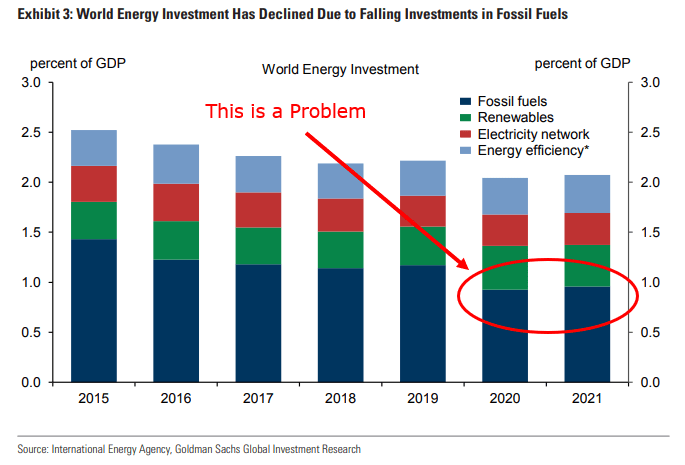
After more than a decade of excess oil supply, the world has grown accustomed to the risk of oversupply in the oil market. However, with oil investment falling to the lowest levels of the last decade, capital starvation is setting the stage for potential supply shocks as the key tail-risk going forward.
We can see clear evidence of capital impairment across the board, including in the U.S. shale patch. Despite oil reaching as high as $85 per barrel in 2021, U.S. production remains 1.5 million barrels per day below pre-COVID highs. This is a 180-degree inversion from the shale boom era, when $60 oil was enough to incentivize new record highs in U.S. production.
All signs indicate further shale capital restraint into 2022, based on current rig count trends and capex plans from the major American E&Ps.
Of course, the story of shale capital impairment has been well covered. The lesser talked about phenomenon is a similar investment pullback among key OPEC+ producers, like Saudi Arabia. The chart below shows the Saudi rig count sitting at the lowest levels in more than 13 years:
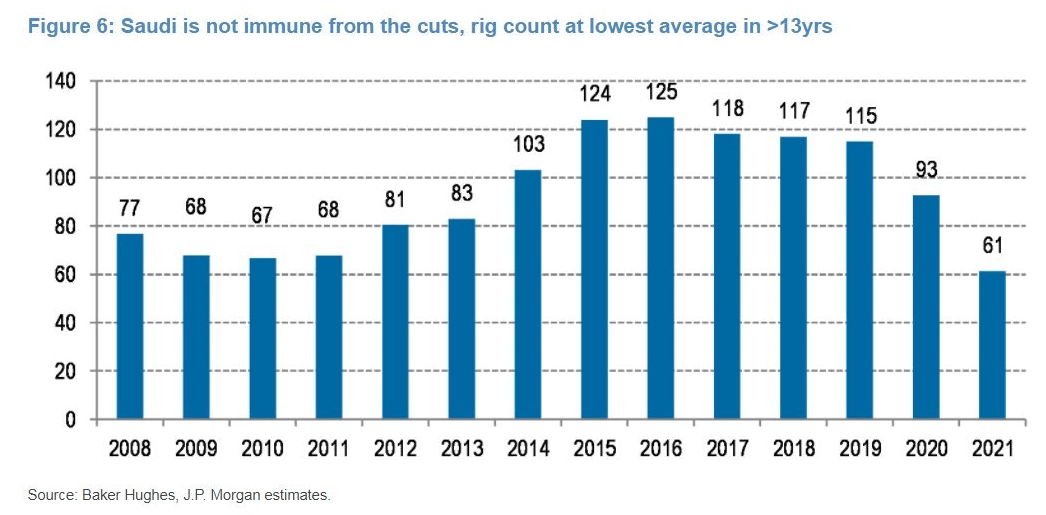
Meanwhile, there’s growing chatter that Russia, the world’s third largest oil producer, might also be running up against its production limit, as Bloomberg recently reported:
Russia failed to boost oil output last month despite a generous ramp-up quota in its OPEC+ agreement, indicating the country has deployed all of its current available production capacity.
So even as OPEC+ remains on the output hiking path, including the recent announcement of a 400,000 barrel/day increase beginning in February, the big question remains: how much global spare capacity exists to meet record highs in demand this year and beyond?
Throw in the potential for a geopolitical disruption in a major producing region, like the recent turmoil in Kazakhstan, and $100 oil could be just the beginning of the next leg higher in prices.
Finally, there’s a macroeconomic precedent for a bullish energy view in 2022.
Late Cycle Expansions Favor Commodities, like Crude Oil
History shows that commodities—and energy in particular—enjoy some of their best returns in late cycle economic expansions.
Supporting the idea of a late cycle U.S. expansion is the Treasury yield curve. Specifically, the spread between 2- and 10-year Treasuries. This spread has inverted (i.e. gone negative) before every major recession of the Post-War era. The compressing yield curve started throwing off warning signs in 2021, although there’s still some way to go before reaching a curve inversion:

Source: Ross Report, with data from the St Louis Fed
Consider two of the most recent economic case studies…
During the Housing Bubble, real estate prices peaked and started rolling over in 2006. However, this was only the beginning of a parabolic rally in crude oil. Starting from the already-elevated price of $50 per barrel in January 2007, crude prices rallied for another 18 months before reaching an all-time high of $147 by July of 2008.
Soaring inflation, partially caused by higher energy prices, ultimately helped pop the Housing Bubble. The inflation outbreak that helped pop the asset bubble in 2008 might provide a useful template for what to expect for the broader financial markets 2022 and beyond.
But I believe the far more relevant analogy for today's market is the late stage Dot Com bubble. During the final NASDAQ melt up in 1999, crude oil rallied from $12 per barrel in January 1999 to a high of $37 per barrel in October of 2000.
Notably, crude continued gaining ground for months after the peak in stock prices. And even as the Dot Com bubble crashed, crude stabilized at a lower high, before enjoying one of the greatest bull runs of all time in subsequent years.
It was the underinvestment of the 1990s that set the stage for the “Commodities Supercycle” of the early 2000s. During the Dot Com mania, there was simply more money to be made speculating in high-flying tech stocks. So, commodities were mostly ignored by the investment community.
Sound familiar?
Given the scope of today's energy capital impairment in the backdrop of a roaring mania in the broader stock market, the Dot Com episode provides a useful template for what to expect when today’s cycle turns. Specifically, I believe the energy sector could enjoy a certain degree of stability, even as today's stock market boom turns to bust.
Relevant ETFs:
- United States Oil Fund, LP (NYSE:USO)
- Energy Select Sector SPDR® Fund (NYSE:XLE)
- SPDR® S&P Oil & Gas Exploration & Production ETF (NYSE:XOP)
Disclosure: Find out more about my investing strategies here.
